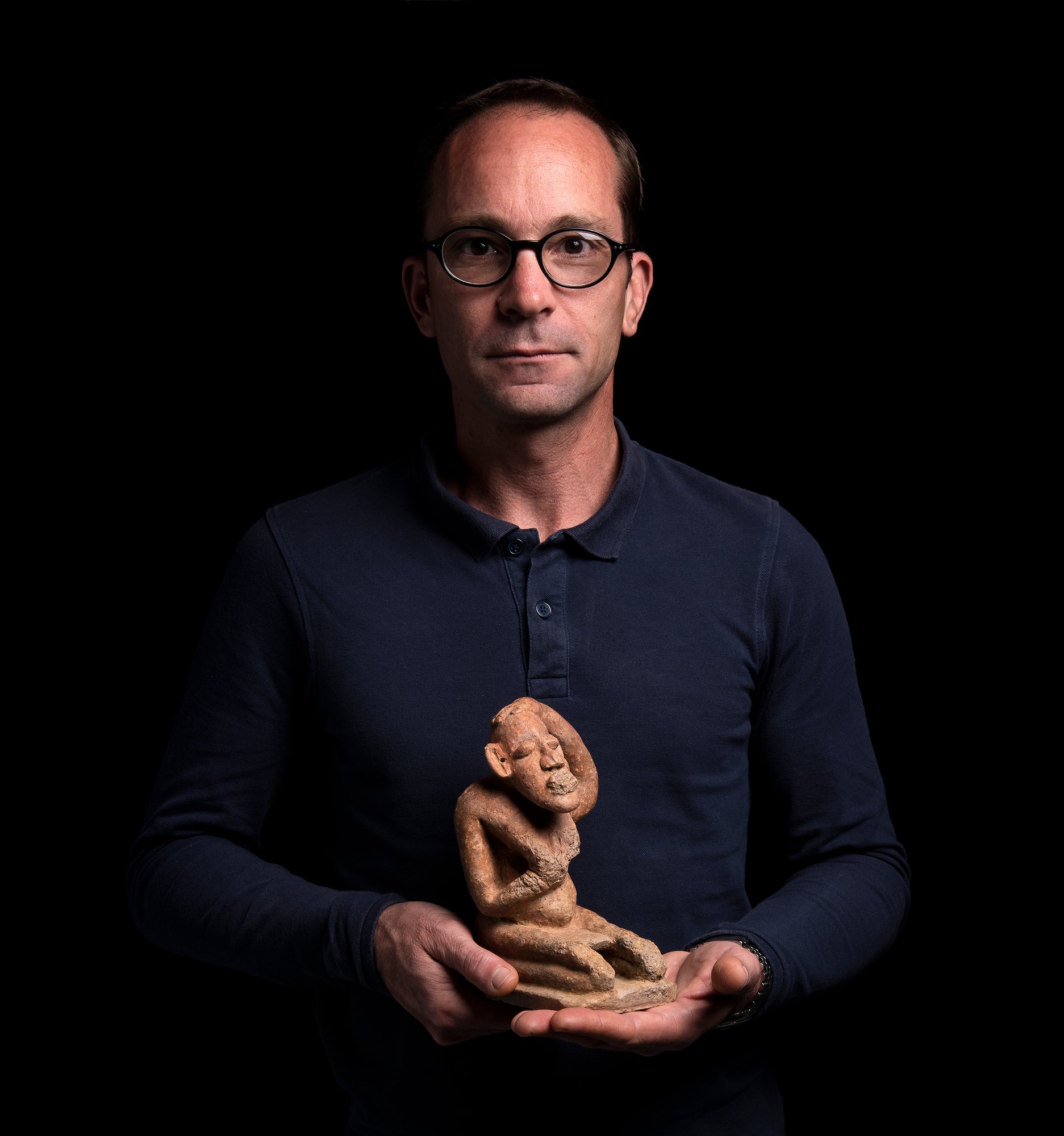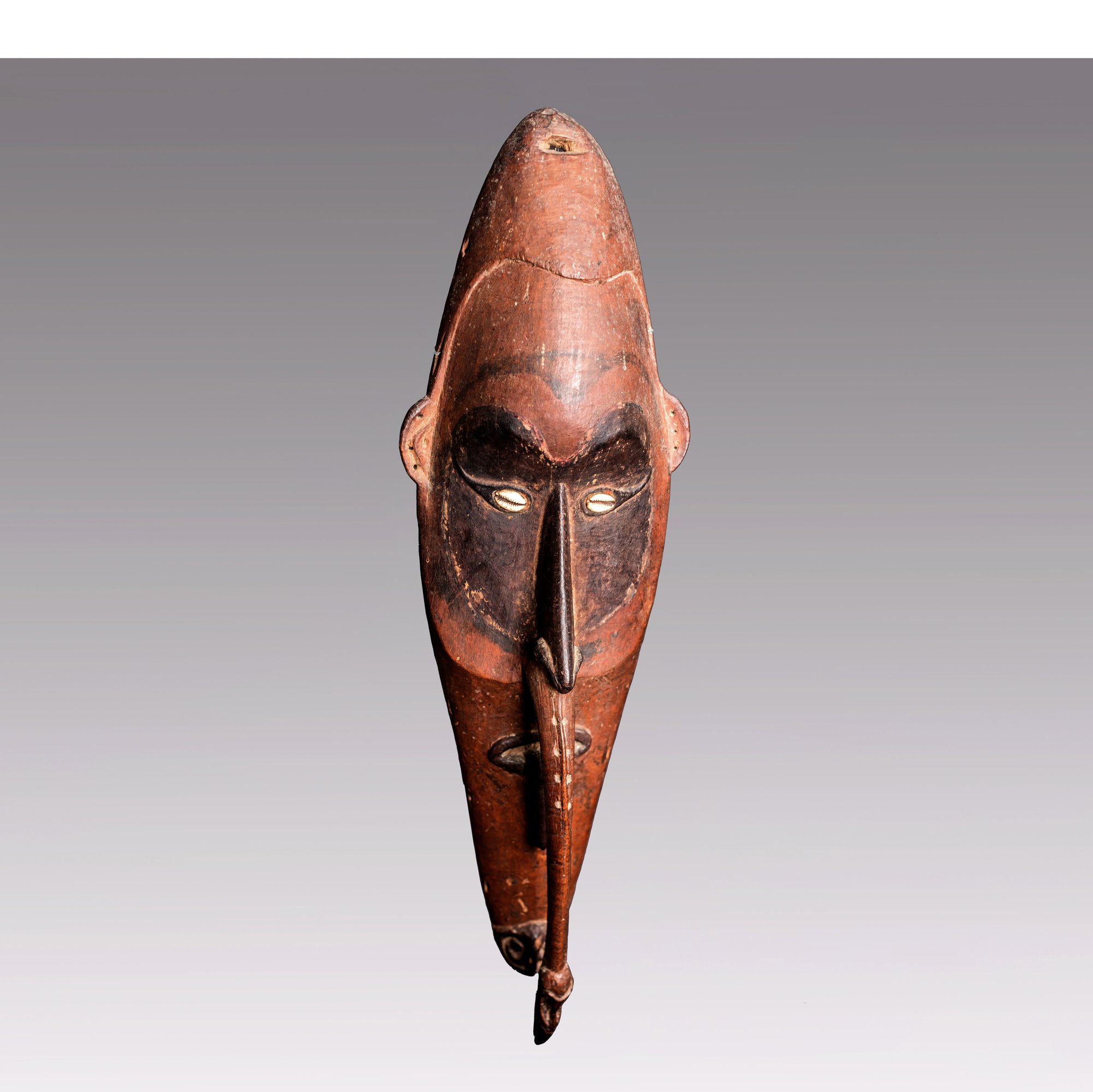Laurent Granier: A restrained collector
Saint-Pol-de-Léon, 17 April 2019

I got to know you on twitter, at the time you were posting intensively objects from the Quai Branly Museum database, curating your own virtual exhibition, mostly with unknown objects from the reserves. Your virtual exhibition ‘Early Côte d'Ivoire’ was even acclaimed by an impromptu tweet from the NY Times’ Chief art critic Roberta Smith...
And I had the time of my life that day... It was also great to interact with a very diverse audience, from museum curators to artists or people just curious to learn. Many young collectors have a very active phase of discovery and intense learning. Going through the 300.000 objects of the Quai Branly Museum database has been the way to express mine.
How did you get that passion for Tribal art?
15 years ago I visited some colleagues, a Belgian and a French, in Dakar. They were buying African art like crazy. Of course, these were copies... but at least I had a spark for the African aesthetics and my treasure hunter sense was unlocked. Fortunately I had a lawyer reaction [Laurent Granier in an environmental lawyer] and I bought the books early enough. I didn't wasted too much time with fakes. For my growing interest in New Guinea arts I was quickly in touch with dealer Michael Hamson who has been very patient and educated me a lot in my early years. But I keep rediscovering ethnographic arts every day: What authenticity is, what makes good art, why do I need to own objects... These are all questions I am still finding answers to.

What types of objects do you collect?
I like to think I collect objects that carry the essence of the cultures that produced them. Objects that connects to the past and to very different cultures, so as to feed our lifes with different perspectives and values. Collecting is like a journey, through cultures, through history, through knowledge, through yourself. That said, it's more a matter of opportunity. The objects are like in an hourglass: You look at all of them, some will seduce you based on your taste, you study those and then maybe, just maybe, you'll finally manage to acquire one and become its temporary custodian.
Do you collect art from particular areas?
Yes and no. Of course collecting fields emerge with time. Those I have been initiated to, and those where I got more documentation. I have an immoderate love for Southern African arts - Zulu in particular. It is art that suggests more than imposes. It's abstract, you have to walk half the way to get it. To the opposite Melanesian arts, the Sepik in particular, which I know a little more, strikes you. The arts from ancient Mali fascinate me also a great deal, but for other reasons. But come back in a few years and I will mention Fang or Maori.
What is a good collection to you?
A good collection is a work of art in itself. You can feel a good collection immediately, there is a coherence in it, or there is a variety with connexions and dialogues. A good collection can be small or large. A good collection evolves over time. Money don't make a good collection. It helps a lot though. One must accept (and enjoy) collecting ethnographic arts as a learning process I think.
What is your favourite piece in your collection?
My latest acquisition is always my favourite! No I don't really have a favourite. But for this interview I have selected four recent acquisitions.

How often do you add to your collection, and how?
My tastes are becoming more and more expensive so I am acquiring one or two great pieces on an average year and a few smaller things to keep the buzz going. That's the advice I am giving to young collectors: Buy little but really good. I buy at auction, through dealers and to collectors. As much as possible I try to see the object in person. It is very important to feel that physical connexion. When the heart is beating hard it's usually a very good sign. The brain is there to validate the emotion.
But practically how do you operate? You said it was more a matter of opportunity.
Yes it is. So the ideal is to put aside a budget first and wait like a leopard in a tree. I look at everything: dealers, auctions, online, fairs. Except in the fields I have some connoisseurship in, I usually buy after a second view from an expert or a scholar in the concerned field. But it never happens exactly that way of course... You must be reactive, there is competition. Then you must also refrain yourself and let those cute things pass. To accept to miss your target also sometimes. The dream piece pops up when you less expect it anyway... The hunt in a word.
Do you think it's necessary to have knowledge of the history or traditional use of the pieces you collect?
Like most african and oceanic art aficionados I feel a necessity (and a responsability) to understand the cultural dimensions of the objects, to fully appreciate the art you live with. But it is equally important to have a personal connexion with the object as a sculpture.
How do you deal with fakes and copies?
Not only are there plenty of fakes, it is a known fact, but there are also plenty of late works and plenty of not so interesting old and authentic works. I like to make an analogy with painters: maybe 1% are talented. I see no reasons not to apply that rule to Oceania or African sculptors. You have to discriminate! Now, concerning late works, the more I study museum collections (what pieces were found early on, where, in what quantities, the styles, etc.) the more I suspect many legitimate pieces on the market to have been made for sale. The minute the Congolese, the Malians or the Marquesans saw an interest from Europeans in their material culture, they started carving artworks for sale. This is documented by scholars in almost every single field. Pieces that were later patinated by decades of collector caresses and kitchen smoke. These are the most difficult ones to avoid. It takes a lot of time and luck to get your hands on a really good piece of ancient African or Oceanic art when you run a normal budget.

How do you conduct your researches?
In books, museum collections and through friends. It's all about comparing styles and surface to appreciate age, authenticity and then finally judge plastic qualities. People pay too much attention to surface I think. An object can leave the Congo in the 1950's, spend 50 years in the vapours of a Brussels apartment (and receive multiple collectors caresses) and it will look quite old. Same for a Sepik object that spent just 5 years on a tropical New Guinea rafter. Style is a much better indicator of age.
Who are some of the people that influence you and your collection?
Douglas Newton is my all time heroe when it comes to New Guinea arts. The current Arts of Africa, Oceania and Americas team at the Metropolitan Museum is very impressive. It was a once in a lifetime experience to spend a full month with them when I did my research on Sepik bone daggers. As for collectors I have an immoderate love for the taste of Helena Rubinstein, of Gaston de Havenon, of Jay C Leff, of Saul Stanoff, of John Friede and many others. Talking of knowledgeable or tastefull people, I could also mention many dealers.
Do you consider you made mistakes when you first started collecting?
I didn't made big mistakes honestly. Like everyone I overpaid a bit my first objects. But that's OK, it's part of game when you starting collecting and I am still happy with those objects. Also at some point I thought it was a mistake to buy "ethnographic" objects, because the market was bombarding this idea of "Artworks", masks and figures. But I could not help it but finding beauty and potency in some ethnographic objects. I think true african and oceanic art collectors love ethnographic because they understand they are part of the wider "ecocsystem", side by side with ceremonial objects, dances, songs and tales. Just forget about the resale value, unless they are very very good ethnographic objects.

What do you wish you knew when you started collecting?
Yale Raai and the Van Rijn archives. Artkhade did not exist at the time. And my base-maker, Romain Laforet from Lyon, who does a superb job.
Could you stop collecting?
No. I even work on the next generation to carry on with the adventure.
Do you like to share your collection with others?
Not really... I am a bit secretive with my collection, mostly because I consider it in its infancy. But sometimes I have to sell and then it is reassuring to see the object going to a good auction house or to a dealer or a collector I respect.
What advice would you have for collectors starting out in tribal art?
The usual ones : buy the books first and visit the museums, including the databases online. Entries in auction catalogues and essays in Dealers catalogues are also excellent sometimes. Then find reliable sources - dealers, experts, advisors - who can help you growing your taste and knowledge. Finally learn to be attentive to your emotions, to your instinct, and let those to soulmate objects come to you.
Twitter: @perlesduquai Instagram: @granierancient Website: www.granierancient.com